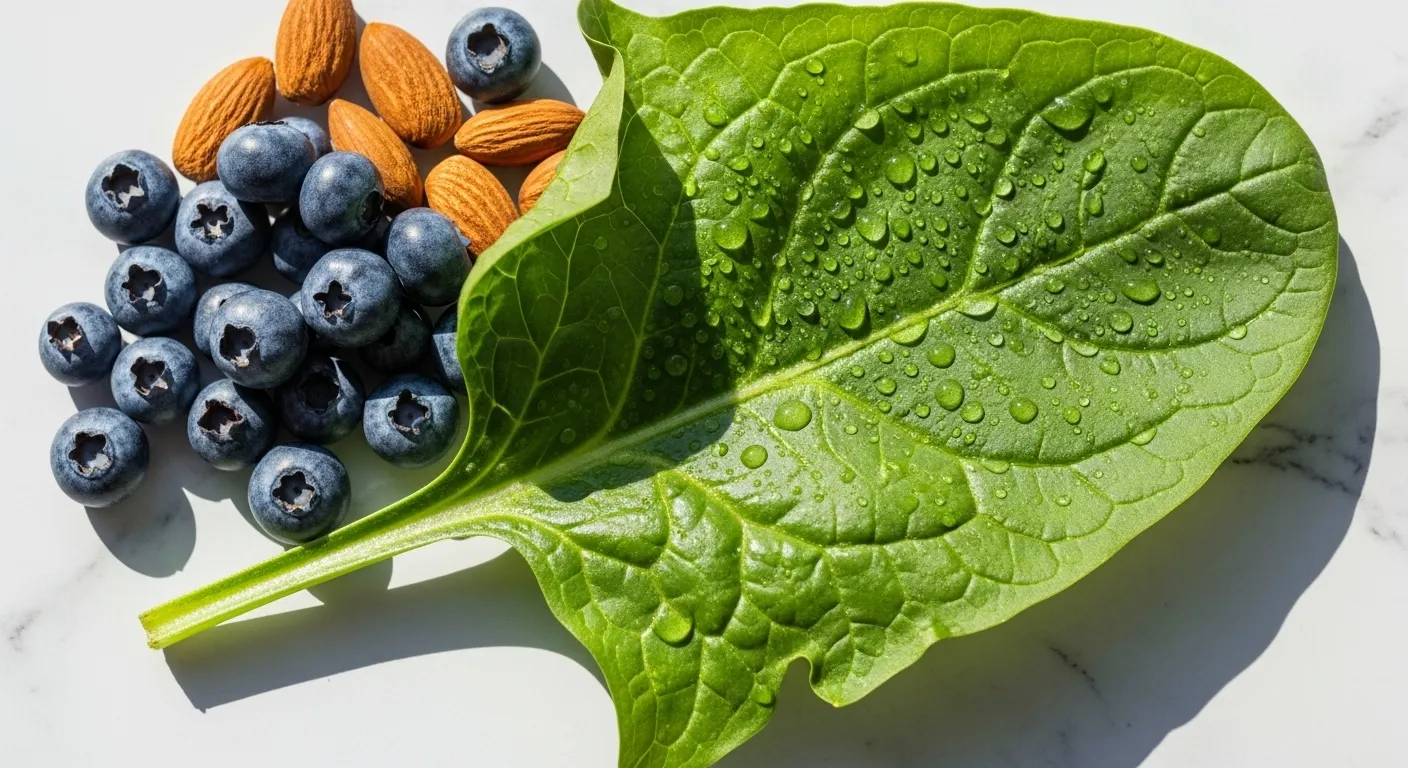

Introduction: Prioritizing Your Health with Nutrient-Rich Foods
As we navigate our golden years, the desire to feel energetic, sharp, and healthy is more important than ever. The concept of “anti-aging” isn’t about turning back the clock, but rather about enriching our lives and maintaining our independence for as long as possible. A cornerstone of this journey is nutrition. The foods we eat provide the fundamental building blocks our bodies need to function well, repair damage, and defend against illness. This is where the idea of “superfoods” comes in, a term often used to describe foods packed with an exceptional amount of nutrients.
While no single food is a magic bullet, incorporating a variety of nutrient-dense foods into your diet is a powerful step toward promoting healthy aging. These so-called superfoods are often rich in antioxidants, vitamins, minerals, and healthy fats that can support everything from brain health to bone strength. Think of your plate as a toolkit for your well-being. By choosing the right tools, you can actively support your body’s natural processes, manage chronic conditions, and enhance your overall quality of life. This guide will explore some of the top science-backed foods that can contribute to your senior wellness journey, all while keeping safety and practicality at the forefront.

Understanding the Health Benefits (and Any Risks) of Longevity Foods
The term “superfood” is more of a marketing concept than a scientific one, but it points to a very real and important idea: some foods are exceptionally beneficial for our health. These longevity foods work their magic by providing a concentrated dose of compounds that our bodies need to thrive, especially as we age. Let’s break down the key benefits and potential precautions.

The Power of Antioxidants and Anti-Inflammatories
Many of the health challenges associated with aging are linked to two key processes: oxidative stress and chronic inflammation. In simple terms, oxidative stress is like rust on a car; it’s a form of damage to our cells caused by unstable molecules called free radicals. Antioxidants, found abundantly in colorful fruits and vegetables, are substances that neutralize these free radicals, protecting our cells from this damage.
Chronic inflammation, on the other hand, is a persistent, low-level activation of the immune system that can contribute to conditions like heart disease, arthritis, and dementia. Many nutrient-dense foods contain powerful anti-inflammatory compounds that help calm this response, supporting long-term health. Authoritative health information for seniors is provided by the National Institute on Aging (NIA) and the Centers for Disease Control and Prevention (CDC).

Supporting a Healthy Heart and Brain
As we get older, maintaining cardiovascular and cognitive health is paramount. Foods rich in omega-3 fatty acids, like fatty fish, are proven to support heart health by lowering blood pressure and reducing triglycerides. They also play a crucial role in brain function, helping to protect memory and cognitive skills. The connection between diet and mental clarity is strong, and choosing brain-boosting foods is an investment in your mental well-being. For mental health support, consult the National Institute of Mental Health (NIMH).

Potential Risks and Important Considerations
While these foods are overwhelmingly positive, it’s crucial to be aware of potential interactions, especially if you have pre-existing health conditions or are taking medications. The most common consideration for seniors involves leafy green vegetables and blood-thinning medications.
- Vitamin K and Blood Thinners: Leafy greens like spinach and kale are high in Vitamin K, which plays a role in blood clotting. If you take a blood thinner such as warfarin (Coumadin), a sudden, drastic increase in your Vitamin K intake can make your medication less effective. The key is consistency, not elimination. It’s vital to speak with your doctor about maintaining a stable intake of these healthy foods so your medication dosage can be managed appropriately.
- Food Allergies and Intolerances: Nuts, seeds, and fish are common allergens. If you have a known allergy, you must avoid these foods. If you suspect an intolerance, speak with your doctor or a registered dietitian.
- Portion Control: Even healthy foods have calories. Nuts, seeds, and dark chocolate are nutrient-dense but also high in calories and fat. Enjoy them in moderation to maintain a healthy weight.

A Step-by-Step Guide to Adding Superfoods to Your Diet Safely
Incorporating these powerful foods into your meals doesn’t have to be complicated or expensive. The goal is to make small, sustainable changes. Here is a practical guide to some of the best foods for healthy aging and simple ways to enjoy them.

1. Berries: The Antioxidant Powerhouses
Why they’re great: Blueberries, strawberries, raspberries, and blackberries are loaded with antioxidants called anthocyanins, which give them their vibrant colors. These compounds help protect the brain and may improve memory and cognitive function.
How to enjoy them safely:
- Add a handful of fresh or frozen blueberries to your morning oatmeal or plain yogurt.
- Blend strawberries into a smoothie with milk or a milk alternative.
- Simply enjoy a small bowl of mixed berries as a refreshing and healthy dessert.

2. Leafy Greens: The Nutrient-Dense Champions
Why they’re great: Spinach, kale, and collard greens are packed with vitamins A, C, and K, as well as calcium and fiber. They support bone health, vision, and healthy digestion.
How to enjoy them safely:
- Add a handful of fresh spinach to your scrambled eggs or omelet in the morning.
- Sauté kale with a little olive oil and garlic as a simple side dish. Remember to be consistent with your intake if you are on blood thinners and have discussed it with your doctor.
- Blend a small amount of greens into a fruit smoothie; you often won’t even taste it!

3. Fatty Fish: The Omega-3 Stars
Why they’re great: Salmon, mackerel, sardines, and trout are rich in omega-3 fatty acids, which are crucial for reducing inflammation and protecting against heart disease and cognitive decline.
How to enjoy them safely:
- Bake or broil a salmon fillet with lemon and herbs. Aim for two servings of fatty fish per week.
- Try canned salmon or sardines (packed in water) mixed into a salad or on whole-grain crackers for an easy and affordable lunch.
- Avoid heavily fried fish, as this can add unhealthy fats.

4. Nuts and Seeds: The Healthy Fat Heroes
Why they’re great: Walnuts, almonds, flaxseeds, and chia seeds are excellent sources of healthy fats, protein, and fiber. Walnuts are particularly high in a type of omega-3 fatty acid that is beneficial for brain health.
How to enjoy them safely:
- Sprinkle a tablespoon of chopped walnuts or ground flaxseed over your cereal or yogurt.
- Enjoy a small handful (about a quarter-cup) of almonds as a satisfying snack.
- Be mindful of portion sizes, as nuts are calorie-dense. Choose unsalted varieties to help manage sodium intake.

5. Whole Grains: The Fiber Foundation
Why they’re great: Oats, quinoa, brown rice, and whole-wheat bread are rich in fiber, which is essential for digestive health, blood sugar control, and maintaining a healthy weight. They provide sustained energy throughout the day.
How to enjoy them safely:
- Start your day with a warm bowl of oatmeal, topped with berries and a sprinkle of nuts.
- Swap white rice for quinoa or brown rice as a side dish for your lunch or dinner.
- Choose bread and crackers that list “100% whole wheat” or another whole grain as the first ingredient.

6. Legumes: The Plant-Based Protein Providers
Why they’re great: Beans, lentils, and chickpeas are fantastic sources of protein, fiber, and essential minerals like iron and potassium. They are also incredibly affordable and versatile.
How to enjoy them safely:
- Add a can of rinsed, low-sodium chickpeas or kidney beans to your favorite salad.
- Make a hearty lentil soup, which is both comforting and incredibly nutritious.
- If you are not used to a high-fiber diet, introduce legumes slowly to allow your digestive system to adjust.

Key Signs It’s Time to Consult a Doctor or Dietitian
While improving your diet is a wonderful goal, it should always be done with safety in mind. Your body is unique, and what works for one person may not be right for another. It is absolutely essential to seek professional medical advice before making significant dietary changes, especially if you have chronic health conditions. Never hesitate to contact your healthcare provider.
Here are key signs that you should consult a doctor or a registered dietitian:
- You have a chronic condition: If you live with diabetes, kidney disease, heart disease, high blood pressure, or any other ongoing health issue, your dietary needs are specific. A professional can help you create a plan that supports your health without causing harm.
- You are taking multiple medications: Many foods can interact with prescription medications. Your doctor or pharmacist can review your list of medications and advise you on any potential food-drug interactions, such as the one between Vitamin K and blood thinners.
- You experience new or worsening digestive issues: If adding new foods causes persistent gas, bloating, diarrhea, constipation, or heartburn, it’s a sign that you should seek medical guidance.
- You have trouble chewing or swallowing: These difficulties can lead to poor nutrition and pose a choking hazard. A doctor or speech pathologist can help identify the cause and recommend safe food textures and preparation methods.
- You notice unexplained weight changes: Sudden or unintentional weight loss or gain can be a sign of an underlying medical issue that needs to be addressed by a professional.
- You are considering taking supplements: Do not start taking vitamin, mineral, or herbal supplements without first consulting your doctor. They can be harmful if taken in the wrong dose or if they interact with your medications.

Making It a Part of Your Daily Routine
Consistency is the key to reaping the long-term benefits of a healthy diet. The goal is not perfection, but progress. Here are some simple, practical tips to make these nutrient-dense foods a regular part of your life.
Start Small and Be Patient. Don’t try to overhaul your entire diet overnight. Choose one or two new foods to try each week. For example, this week you might focus on adding a serving of berries to your breakfast. Next week, you could try swapping white bread for whole-wheat bread. Small, gradual changes are much more likely to stick.
“Eat the Rainbow.” This is a simple and memorable way to ensure you’re getting a wide variety of nutrients. Try to include foods of different colors on your plate at every meal: red from tomatoes or strawberries, green from spinach or broccoli, orange from carrots or sweet potatoes, and blue or purple from blueberries or eggplant.
Plan Ahead. Take a few minutes each week to think about your meals. Make a simple grocery list that includes plenty of fruits, vegetables, lean proteins, and whole grains. When healthy foods are readily available in your kitchen, you’re more likely to choose them.
Keep Healthy Snacks Accessible. Place a bowl of fruit on your counter. Pre-portion small bags of nuts or seeds. Having healthy options within easy reach can help you avoid less nutritious choices when you feel hungry between meals.
Hydrate Wisely. Don’t forget the importance of water! Proper hydration is crucial for digestion, energy levels, and overall health. Sometimes our bodies mistake thirst for hunger. Try drinking a glass of water first when you feel a pang of hunger.
Listen to Your Body. Pay attention to how different foods make you feel. A healthy diet should leave you feeling energized and well, not uncomfortable or deprived. Find the healthy foods you genuinely enjoy and build your meals around them.

Frequently Asked Questions
1. Are frozen or canned fruits and vegetables as healthy as fresh ones?
Yes, they can be excellent and often more affordable options. Produce is typically frozen or canned at its peak ripeness, locking in nutrients. When choosing canned goods, look for varieties packed in water or their own juice, and select low-sodium or no-salt-added options for vegetables. Rinsing canned beans and vegetables before use can also help reduce their sodium content.
2. I’m on a fixed income. How can I afford to eat these “superfoods”?
Healthy eating does not have to be expensive. Some of the most nutrient-dense foods are also the most budget-friendly. Focus on staples like dried or canned beans, lentils, oats, and brown rice. Look for seasonal produce, which is often less expensive, and don’t overlook frozen fruits and vegetables, which can be cheaper than fresh and last much longer, reducing waste.
3. Do I need to take supplements to get these anti-aging benefits?
For most people, it is always best to get nutrients from whole foods rather than pills. The combination of vitamins, minerals, fiber, and other compounds in food works together in ways that supplements cannot replicate. Supplements can also pose risks and interact with medications. You should never start a new supplement without first discussing it with your doctor to ensure it is safe and appropriate for you.
4. Does Medicare cover nutrition counseling?
In some cases, yes. Medicare Part B may cover medical nutrition therapy (MNT) services if you have certain conditions, such as diabetes or kidney disease, and have a referral from your doctor. These services are provided by a registered dietitian who can help you create a personalized eating plan. To understand your specific coverage, it is best to consult official resources. For insurance and medical coverage questions, refer to Medicare.gov.
Disclaimer: This article is for informational purposes only and does not constitute medical advice. The content is not intended to be a substitute for professional medical advice, diagnosis, or treatment. Always seek the advice of your physician or other qualified health provider with any questions you may have regarding a medical condition.
|
Fact-Checked Content
Our editorial team reviews all content for accuracy and updates it regularly. Learn about our editorial process →
|

















